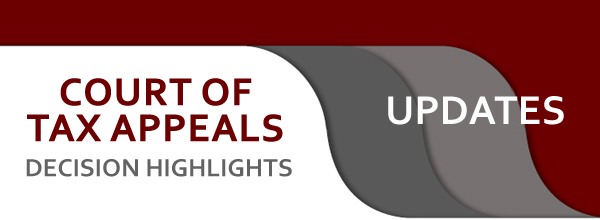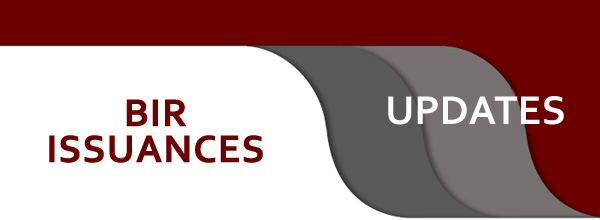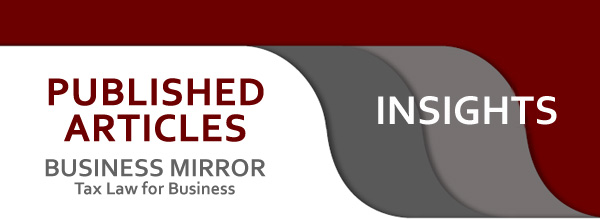

NOVEMBER • VOL. 11 • SERIES OF 2022
INSIGHTS is a monthly publication of BDB LAW to inform, update and provide perspectives to our clients and readers on significant tax-related court decisions and regulatory issuances (includes BIR, SEC, BSP, and various government agencies).

DISCLAIMER: The contents of this Insights are summaries of selected issuances from various government agencies, Court decisions, and articles written by our experts. They are intended for guidance only and as such should not be regarded as a substitute for professional advice.
Copyright © 2022 by Du-Baladad and Associates (BDB Law). All rights reserved. No part of this issue covered by this copyright may be produced and/or used in any form or by any means – graphic, electronic, and mechanical without the written permission of the publisher.
What's Inside ...
- HIGHLIGHTS FOR OCTOBER 2022
- SIGNIFICANT COURT DECISIONS
- Court of Tax Appeals
- SIGNIFICANT REGULATORY ISSUANCES
- Bureau of Internal Revenue
- Bangko Sentral Ng Pilipinas
- Insurance Commission
- Bureau of Customs
- Fiscal Incentives Review Board
- Department of Finance
- PUBLISHED ARTICLE
- Taxability of Equity-Based Compensation
- OUR EXPERTS
- The Personalities
- The Personalities


HIGHLIGHTS for OCTOBER 2022
COURT DECISIONS
- The CIR must always indicate in clear and unequivocal language what constitutes his final determination of the disputed assessment. (JTKC Land, Inc. vs. Commissioner of Internal Revenue, CTA EB NO. 2378, October 5, 2022)
- The presentation of the Authority to Print (ATP) is required only if such ATP is not indicated in the invoices or receipts. (Commissioner of Internal Revenue vs. Macquaries Offshore Services Pty LTD. – Philippine Branch, CTA EB NO. 2440, 03 October 2022)
- A Department of Energy Certificate of Endorsement is not a requirement to be granted VAT zero-rating incentive under the RE Law. (Vestas Services v. Commissioner of Internal Revenue, CTA EB NO. 2479 (CTA Case No. 9544), October 14, 2022)
- The Notice of Informal Conference is a part of due process. Its issuance gives both the taxpayer and the Commissioner the opportunity to settle the case at the earliest possible time without the need for the issuance of a Final Assessment Notice. (Commissioner of Internal Revenue v. IBM Plaza Condominium, CTA EB No. 2229 (CTA case No. 8740), October 14, 2022)
BIR ISSUANCES
- RR No. 13-2022, October 7, 2022 – This prescribes the guidelines, procedures, and requirements for the proper income tax treatment of equity-based compensation.
- RMC No. 136-2022, October 14, 2022 – This publishes FIRB Resolution No. 026-2022 extending 70:30 WFH arrangement for RBEs in the IT-BPM sector and allowing the transfer of registration of existing business enterprises in the IT-BPM to BOI.
- RMC No. 137-2022, October 14, 2022 – This provides clarificatory guidelines on the availment of VAT zero rate (0%) on HMO Plans Acquired by REEs and prescribes the uniform template of "detailed information” thereof.
- RDAO No. 18-2002, October 17, 2022 – This delegate to certain revenue officials the authority to sign warrants of distraint, levy/garnishment, notices of tax liens, encumbrance, levy and seizures, as well as the lifting thereof.
BSP ISSUANCES
- BSP Circular Letter No. CL-2022-054, July 8, 2022 – This provides for the Guidelines on Recovery Plan of Banks.
IC ISSUANCES
- IC Circular Letter CL-2022-44, October 10, 2022 – This provides for the Amended Quarterly Reportorial Requirements of Pre-Need Companies.
- IC Circular Letter CL-2022-48, October 14, 2022 – This provides for the Amendments to Circular Letter No. 2021-27 and Circular Letter No. 2022-34.
BOC ISSUANCES
- AOCG MEMO 336-2022, October 7, 2022 – Clarification on the Exports Implementation for Economic Zones and Customs Bonded Warehouse.
- AOCG MEMO 345-2022, October 10, 2022 – Issuance of Importation Clearance for any Brandnew Electrical and Electronic Equipment/Machines/Devices.
- OCOM MEMO 129-2022, October 18, 2022 – This prescribes the conditions to avail the fiscal incentives of the CREATE Act and clarification of the posting of bond of RBEs.
FIRB ISSUANCES
- FIRB Advisory No. 008-22, October 19, 2022 – This circulates the DTI Memorandum Circular (MC) No. 22-19, s. 2022 dated October 18, 2022.
DOF ISSUANCES
- DOF Opinion No. 16- 2022, October 6, 2022 – This is a request for clarification on the Tax Treatment of Equity-Based Compensation.
- DOF Opinion No. 18- 2022, October 17, 2022 – This is a request for Review of BIR Ruling No. JV-317- 2022 dated 28 June 2022


The CIR must always indicate in clear and unequivocal language what constitutes his final determination of the disputed assessment..
This is an assessment for alleged deficiency tax for taxable year 2010. On January 10, 2014, JTKC received a Formal Letter of Demand (FLD). In response to the FLD, JTKC filed a protest in the form of request for reinvestigation. Without resolving the protest, the BIR issued a Preliminary Collection letter which was received by JTKC on July 4, 2014.
The court ruled that JTKC should have filed an appeal with the CTA within thirty (30) days from receipt of the Preliminary Collection Letter (PCL).
Amidst the differing acts and documents that may be considered as a final decision, the Supreme Court has time and again reminded the CIR and/ or his duly authorized representatives to "always indicate to the taxpayer in clear and unequivocal language what constitutes his final determination of the disputed assessment."
In this case, the Court consider the PCL as having passed the standard set by the Supreme Court as having the tone of finality. The categorical demand for payment coupled with the threat to pursue collection of the alleged tax liabilities if payment is not made, characterize the finality of the decision of the representative of the BIR which to the mind of this Court, constitutes a final decision. (JTKC Land, Inc. vs. Commissioner of Internal Revenue, CTA EB NO. 2378, October 5, 2022)
A LOA does not partake a particular form. Any document may qualify as a LOA provided that the essential requisites of a LOA are present.
A Letter of Authority (LOA) does not partake a particular form. Any document may qualify as a LOA provided that the essential requisites of a LOA are present.
To be effective, a LOA must be issued either by the CIR himself or by his duly authorized representative. Under Section 13 of the NIRC, the duly authorized representative is the Revenue Regional Director. Section D (4) of RMO No. 43-90 expanded the list of duly authorized representatives who may issue Letters of Authority:
1. Regional Directors;
2. Deputy Commissioners;
3. Commissioner; and
4. Other officials that may be authorized by the Commissioner for the exigencies of service.
In the present case, the subject MOA was issued by a mere Revenue District Officer, Albino M. Galanza. This signatory is not among those listed above. Hence, the subject MOA cannot qualify as a valid LOA. (Banclife Insurance Co., Inc., vs. Commissioner of Internal Revenue, CTA CASE NO. 9939, October 5, 2022)
The presentation of the ATP is required only if such ATP is not indicated in the invoices or receipts.
This is an appeal on the CTA Division partial grant of refund in favor of Macquaries on its unutilized input tax attributable to its zero-rated sales for FY 2015. The CIR on appeal argues that Macquaries failed to present its authority to print and permit to loose leaf for the official receipts and invoices. Thus, the claim for refund should be denied.
The Court ruled that the presentation of the Authority to Print (ATP) is required only if such ATP is not indicated in the invoices or receipts. The Supreme Court, in Silicon Philippines, Inc. v. Commissioner of Internal Revenue, clarified that without the indication of the ATP, the presentation of the ATP itself would be "the only way to verify whether the invoices or receipts are duly registered".
In the instant case, the CTA 3rct Division found that Macquarie's official receipts and service invoices contain the details of its ATP. (Commissioner of Internal Revenue vs. Macquaries Offshore Services Pty LTD. – Philippine Branch, CTA EB NO. 2440, 03 October 2022)
Courts cannot simply presume that: (1) a LOA was validly issued; and (2) that the revenue officers who actually conducted the audit of the taxpayer’s books and records up to its completion are clothed with the requisite authority to perform the same pursuant to a validly-issued LOA.
The Court En Banc maintains its position that the presumption of regularity in the performance of official duties as well as the presumption of correctness of tax assessment cannot be invoked as they never materialized due to the absence of proof as to the existence of the facts upon which they may be based. The existence of a valid LOA and the revenue officer's possession of the requisite authority (pursuant to a valid LOA) to conduct an audit of the taxpayer’s books of accounts and other accounting records are precisely the basic facts that could give rise to the inference that the assessments were regularly issued and that the same are prima facie correct.
These basic facts could have easily been established by the presentation of the LOA itself and also by the testimonies of the revenue officers who actually conducted and completed the audit of the taxpayer’s books of accounts and other accounting records pursuant to such LOA.
The BIR, however, did not present any evidence at all. As stated in the Assailed Decision, this Court cannot simply presume that: (1) a LOA was validly issued; and (2) that the revenue officers who actually conducted the audit of the taxpayer’s books and records up to its completion are clothed with the requisite authority to perform the same pursuant to a validly-issued LOA, to sustain the BIR’s bare invocation of the above-mentioned presumptions. (Commissioner of Internal Revenue v. Marily Development Corporation, CTA EB No. 2450 (CTA Case No. 9756), October 12, 2022)
A Department of Energy (“DOE”) Certificate of Endorsement is not a requirement to be granted VAT zero-rating incentive under the RE Law.
This is an appeal on the denial of the CTA Division of Vestas claim for VAT refund on the ground of non-presentation of Department of Energy (“DOE”) Certificate of Endorsement.
On appeal, Vestas argues that DOE endorsement is required only for the importation of RE machinery, equipment and materials. All other incentives including VAT zero-rated status of local purchases of goods and services make no reference to a DOE endorsement for availment of such incentives.
The Court agrees. "Endorsement" is only needed for duty-free importation of RE machinery, equipment, and materials, and its subsequent sales. Thus, with respect to the services EDC purchased or secured from the taxpayer, to avail the VAT zero-rating incentive to the said purchases, the COE appears not to be a requisite. Hence, the COE of EDC is not an evidence to be expected from the taxpayer to present or produce. (Vestas Services v. Commissioner of Internal Revenue, CTA EB NO. 2479 (CTA Case No. 9544), October 14, 2022)
The NIC is a part of due process. Its issuance gives both the taxpayer and the Commissioner the opportunity to settle the case at the earliest possible time without the need for the issuance of a Final Assessment Notice.
The Notice of Informal Conference (NIC) is a part of due process. Its issuance gives both the taxpayer and the Commissioner the opportunity to settle the case at the earliest possible time without the need for the issuance of a Final Assessment Notice. However, this purpose is not served in the instant case because records do not show that a NIC was issued. Thus, for failure to observe the due process requirement, the assessment is void.
Although the issuance of the NIC was not one of the issues stipulated by the parties, it is a related issue that this Court deemed imperative to decide for the achievement of an orderly disposition of the case. This is allowed under Section 1, Rule 14 of the RRCTA
Under Section 1, Rule 14 of A.M. No. 05-11-07-CTA, or the Revised Rules of the Court of Tax Appeals, the CTA is not bound by the issues specifically raised by the parties but may also rule upon related issues necessary to achieve an orderly disposition of the case
The above section is clearly worded. On the basis thereof, the CTA Division was, therefore, well within its authority to consider in its decision the question on the scope of authority of the revenue officers who were named in the LOA even though the parties had not raised the same in their pleadings or memoranda. (Commissioner of Internal Revenue v. IBM Plaza Condominium, CTA EB No. 2229 (CTA case No. 8740), October 14, 2022)
A MOA or a mere Letter may be considered a valid and effective LOA, provided that it was issued by the CIR or any of his duly authorized representative.
A LOA was issued authorizing an RO and a GS to audit/examine the taxpayer for possible deficiency tax liabilities. Subsequently, a Letter, dated 15 April 2016, and a MOA, dated 13 April 2016, were issued by the Revenue District Officer transferring the audit to another RO and GS. In contesting the assessment, the taxpayer argues that the Letter of Reassignment cannot be treated as an equivalent of a LOA because it failed to comply with the essential requirements of a LOA.
The Court ruled that any document may qualify as a LOA provided that the essential requisites of a LOA are present. To be effective, a LOA must be issued either by the CIR himself or his duly authorized representative. Under Section 13 of the NIRC, the duly authorized representative is the Revenue Regional Director. Under Section D(4) of RMO No. 43-90, the list of duly authorized representatives who may issue LOAs are: (1) Regional Directors; (2) Deputy Commissioners; (3) Commissioner; and (4) other officials that may be authorized by the Commissioner for the exigencies of services. Thus, a MOA or a mere Letter may be considered a valid and effective LOA, provided that it was issued by any of the persons named above. In the present case, the subject Letter and the MOA were issued by a mere Revenue District Officer. This signatory is not among those listed above. Hence, the subject MOA cannot qualify as a valid LOA. (Shang Property Developers, Inc. v. Commissioner of Internal Revenue, CTA Case No. 9745, October 12, 2022)
If generation of revenue is the primary purpose, the imposition is a tax but, if regulation is the primary purpose, the imposition is properly categorized as a regulatory fee.
The taxpayer received orders of payment assessing permit fee to slaughter, and ante-mortem and post-mortem fees. The taxpayer protested the assessment and eventually filed a Petition for Review with the CTA.
The Court dismissed the said petition for lack of jurisdiction, holding that if generation of revenue is the primary purpose, the imposition is a tax but, if regulation is the primary purpose, the imposition is properly categorized as a regulatory fee. In this case, the purpose of the assailed fees under the 2005 Revenue Code of the City of Davao is to regulate the slaughter of animals in City-operated slaughterhouses or those authorized by the City Government. The permit fees to slaughter and ante-mortem and post-mortem fees are impositions on the activity subject of government regulation, which is the operation of slaughterhouses. In other words, the City of Davao is mandated to implement the provisions of EO No. 137, RA No. 9296, and the LGC pertaining to the regulation of slaughterhouses and collection of fees and charges by imposing the assailed permit fees to slaughter and ante-mortem and post-mortem fees under the 2005 Revenue Code of the City of Davao, in the exercise of the State's police power in the form of a fee, even though revenue is incidentally generated. As such, the Court is without jurisdiction. (San Miguel Foods, Inc. v. Office of the City Treasurer, City Of Davao, CTA AC No. 249, October 12, 2022)
A MOA, Referral Memorandum, or such equivalent document directing the continuation of a tax audit or investigation by another revenue officer vests no authority on such revenue officer.
A LOA was issued granting authority to an RO. Subsequently, a MOA, signed by the Revenue District Officer, was issued for the authority of another RO to continue the investigation/examination of the taxpayer’s books of accounts and other accounting records. The taxpayer alleges the lack of authority of the subsequent RO.
As was held by the SC in CIR vs. McDonald's Philippines Realty Corp., the Court En Banc ruled that the use of a MOA, Referral Memorandum, or such equivalent document directing the continuation of a tax audit or investigation by another revenue officer vests no authority on such revenue officer. Further, the practice of reassigning ROs and substituting them with a new set of ROs (without a separate LOA) is a usurpation of the statutory power of the CIR,
In this case, there was no new LOA issued for the subsequent RO Arthur to conduct the investigation of the taxpayer. The investigation and subsequent assessment of the taxpayer’s tax deficiency could not be sanctioned. [Commissioner of Internal Revenue v. Misamis Oriental Rural Electric Service Cooperative I, Inc., (MORESCO I), CTA EB No. 2266 (CTA Case No. 9700), October 12, 2022]
There is a violation of the taxpayer’s due process rights when the CIR merely reiterated the findings stated in the PAN in the FLD/FAN, without giving any reason for rejecting the refutations and explanations of the taxpayer.
In her Motion for Reconsideration, the CIR asserts that the essence of due process is simply an opportunity to be heard, or an opportunity to explain one's side or to seek reconsideration of the action or ruling complained of.
The Court En Banc maintains its position that there was a violation of the taxpayer’s due process rights as the CIR failed to strictly observe the clear mandate of Section 228 of the NIRC of 1997, as amended, in relation to RR 12-99, as amended. The CIR merely reiterated the findings as stated in the undated PAN in the FLD/FAN, without giving any reason for rejecting the refutations and explanations as well as consideration of the taxpayer’s request for clarification as indicated in the latter's Reply to PAN.
Furthermore, the FDDA is bereft of any sufficient explanation or information as to how the figures reflected in the assessments were arrived at. Neither do they contain any reason for rejecting the taxpayer’s contention or request for clarification in its Reply to PAN. The taxpayer was thus left unaware on how the CIR appreciated the explanations or defenses it raised against the undated PAN, in clear violation of its right. [Commissioner of Internal Revenue v. Morning Star Milling Corporation, CTA EB No. 2419 (CTA Case No. 9294), October 10, 2022]
Despite the alleged review of a person named in the LOA, the CIR may not utilize the subsequent RO’s findings as basis of the assessment issued against the taxpayer.
A LOA was issued granting authority to an RO and GS to examine the books of the taxpayer. Subsequently, a MOA signed by Chief Escalada was issued to authorize another RO. The CIR asserts that the findings of the subsequent RO was reviewed by the GS who is named in the LOA. Thus, the tax assessment based on the subsequent RO's findings, as reviewed by the GS, is valid.
The Court ruled that Article 2254 of the Civil Code ordains that no vested or acquired right can arise from acts or omissions which are against the law or which infringe upon the rights of others. One may not claim any right from an act in violation of the law. The subsequent RO conducted an audit and examination of the taxpayer sans proper authority to do so, from the CIR or his or her duly authorized representatives, offensive of Sections 6, 10, and 13 of the NIRC, as amended. Hence, despite the alleged review of a person named in the LOA, the CIR may not utilize the subsequent RO’s findings as basis of the assessment issued against the taxpayer. [Commissioner of Internal Revenue v. Golden Brew Marketing, Inc., CTA EB No. 2426 (CTA Case No. 9538), October 6, 2022]
The taxpayer will not be allowed to impugn the validity of the Waivers after reaping the benefits of their execution.
In its Motion for Partial Reconsideration, the taxpayer argues that since waivers would result in the derogation of the taxpayer's rights, it should be given the opportunity to invoke its nullity.
The Court ruled that the taxpayer has already benefitted from its execution of the Waivers as it was able to defer the issuance of the assessments and thus gained more time to submit its supporting documents. Consequently, the Court En Banc could not simply allow the taxpayer to impugn the validity of the Waivers after reaping the benefits of their execution. This is especially so considering that the signatory of said Waivers is no less than taxpayer’s President, who, apart from signing the reply to the PAN and protest to the FAN, had also signed the income tax, VAT, WTC and EWT returns subject of the assessments. [Commissioner of Internal Revenue v. Sabre Travel Network (Philippines), Inc., (Formerly Abacus Distribution Systems Philippines, Inc.), CTA EB No. 2310 (CTA Case No. 9532), October 7, 2022]


RR No. 13-2022,
October 7, 2022
This prescribes the guidelines, procedures, and requirements for the proper income tax treatment of equity-based compensation.
“Equity-based compensation” covers all types of employee equity schemes that come in different forms such as stock options, restricted stock units, stock appreciation rights, and restricted share awards.
It is being granted to existing employees of the grantor as a performance incentive for services rendered by the employees and is typically dependent on performance, outstanding business achievements, and exemplary organizational, technical, or business accomplishments.
The following are the different kinds of Equity-based compensation:
| Kinds of Equity-based Compensation | Definition |
| A. Stock options | Stock options merely entitle the employee to purchase shares at a future date. Thus, unless the options are exercised, the employees do not become shareholders. The period between the grant of stock options and the date when they become exercisable represents the vesting period. |
| B. Restricted share awards | The awards may or may not be subject to a vesting period, as may be specified in the grant. If subject to a vesting period, any unvested shares shall be forfeited if employment is terminated. |
| C. Stock Appreciation Rights (SARs) | The terms and conditions are similar to stock options. However, under the SARS, the optionee may receive (a) shares, (b) cash, or (c) a combination of shares and cash, as determined by the grantor. |
| D. Restricted Stock Units | As with restricted shares, stock units may or may not be subject to a vesting period, as will be specified in the grant. Settlement of vested stock units may be made in the form of (a)shares, (b) cash, or (c) a combination of shares and cash. |
The equity grants are considered compensation to be taxed as such under Section 32 of the NIRC of 1997, as amended, and implemented by RR No. 2-98, as amended. This rule will be applied regardless of the employment status of the grantee-employee who could either be rank-and-file or occupying a supervisory or managerial position, as the law applicable does not make any distinction.
RMC No. 136-2022,
October 14, 2022
This publishes FIRB Resolution No. 026-2022 extending 70:30 WFH arrangement for RBEs in the IT-BPM sector and allowing the transfer of registration of existing business enterprises in the IT-BPM to BOI.
FIRB No. 026-22 allowed the 30% of the total work force to adopt WFH arrangement for Information Technology – Business Process Management (IT-BPM) Registered Business Enterprises (RBEs) within the ecozones or freeport zone, as a temporary measure under Rule 23 of the Corporate Recovery and Tax Incentives for Enterprises Act Implementing Rules and Regulations in view of Presidential Proclamation No. 57 s.2022 from September 13, 2022 until December 31, 2022.
Affected RBEs in the IT-BPM sector may be allowed to transfer their registration to the Board of Investment (BOI) from Investment Promotion Agency (IPA) administering an economic zone or freeport where their project is located until December 31, 2022 to adopt 100% WFH.
RMC No. 137-2022
October 14, 2022
This provides clarificatory guidelines on the availment of VAT zero rate (0%) on HMO Plans Acquired by REEs and prescribes the uniform template of "detailed information” thereof.
This expounds further on the clarification made in Q&A No. 14 of RMC No. 24-2022 on cost items that fall under “other expenditures.” The list provided under RMC No. 24-2022 is not “exclusive”, hence expenditures not listed therein may be allowed for VAT zero-rating, provided the same can be attributed directly.
Health Maintenance Organization (HMO) plans acquired by Registered Export Enterprises (REEs) may be allowed for VAT zero-rating provided that:
• These are for employees directly involved in the operations of the REEs’ registered projects or activities and forming part of their compensation package, for their health maintenance.
• Heath benefits are not only an indispensable tool for building a competitive workforce but also ensure continuous and smooth operation of the registered project or activity
HMO plans for employees’ dependents and for employees not directly involved in the operations of the registered projects or activities of the REEs are not allowed for VAT zero-rating.
REEs availing of VAT zero-rate on the qualified HMO plans shall provide their suppliers detailed information on the HMO plans acquired to ensure that only HMO expenses for qualified employees are given zero-rating.
RDAO No. 18-2022,
October 17, 2022
This delegates to certain revenue officials the authority to sign warrants of distraint, levy/garnishment, notices of tax liens, encumbrance, levy and seizures, as well as the lifting thereof.
This delegates to certain revenue officials the authority to sign/approve and serve/execute the following:
1. Warrant of Distraint and/or Levy;
2. Warrant of Garnishment;
3. Notices of Tax Liens, Notice of Encumbrances, and lifting thereof;
4. Notices of Levy on Real Property and lifting thereof; and
5. Notice of Constructive Distraint of Personal Property.
The following are the signing authority/approving officers and the offices designated to cause the service (designated office) of the aforementioned documents for the proper enforcement of collection on assessment under the jurisdiction of their respective Offices:
| Case Description | Signing/Approving Officer | Designated Office |
| (1) National Office (NO) Cases other than LT Cases | ACIR – Collection Service (CS) or in his absence the Head Revenue Executive Assistant (HREA)-CS | Accounts Receivable Monitoring Division (ARMD) |
| (2) Large Taxpayer Service (LT) Cases | ACIR – Large Taxpayer Service or in his absence HREA-LTS (Programs and Compliance Group) | LT-Collection Enforcement Division (LTCED) |
| (3) Large Taxpayer District Office (LTDO) Cases | Chief-Large Taxpayers District Office (LTDO) or in his absence the Assistant Chief – LTDO | Large Taxpayers District Office (LTDO) |
| (4) Regional Office (RO) Cases | Regional Director or in his absence the Assistant Regional Director | Regional Collection Division (RCD) |
The amount to be reflected in the warrants/notices shall be the total amount of delinquency tax assessed for each type of tax including surcharge and interest, except compromise penalty, against a particular taxpayer as a result of tax investigation or audit, surveillance, etc., or for self-assessed taxes (i.e., returns filed with no payment or underpayment, dishonored checks, etc.)
In undermanned RCDs/LTDOs/LTCED where difficulty in coping with workload is experienced, request for assistance to provide auxiliary revenue officers to aid in the service and execution of the warrants and notices and other process must be sought from the concerned Revenue Offices/LTS to ensure that the same have been acted upon within the period prescribed by the Tax Code, and revenue issuances.
BIR Ruling No. 403-2022, October 05, 2022,
The tax incentive provision under RA 7279 granting exemption from project-related income tax is limited to project contractors on the construction and development of houses and lots or home lots only.
The BIR ruled that the construction of the J.W.D. Construction of Nueva Viscaya State University IP Student Dormitory is outside the definition of “socialized housing” in relation to the tax incentives for the private sector under Section 20 of the Balance Housing Development Program Amendments or RA No. 7279.
The tax incentive provision, granting exemption from project-related income tax is limited to project contractors on the construction and development of houses and lots or home lots only with a view to reduce the cost of housing units for the benefit of the underprivileged and homeless.
Moreover, Section 20(d)(3) if RA No. 7279, as amended, on the exemption from VAT for the project contractor concerned, was already repealed by Section 86 (tt) and (uu) of RA No. 10963.


BSP Circular No. 1158
This provides for the Guidelines on Recovery Plan of Banks.
Scope of Application.
All banks, including government-owned banks, shall maintain a recovery plan on a solo and group-wide basis, as applicable. Foreign bank branches may refer to the recovery plan developed by their respective Head Offices and adopt relevant policies and strategies that are consistent with applicable provisions of this Section and commensurate to the scale of operations in the Philippines
Guiding Principles and Components of the Recovery Plan.
The recovery plan shall contain the following:
a. An executive summary which provides a brief overview of the recovery plan covering the governance arrangements, summary of triggers and indicators, key recovery strategies and the corresponding operational plan for its implementation, among others. ln the case of D-SlBs, the summary shall also indicate the material changes in the recovery plan from the last submission to the Bangko Sentral;
b. Governance arrangements which cover the responsibilities of the board of directors, senior management, business units and self-assessment functions encompassing the entire recovery planning process, including the activation and implementation of recovery options and communication strategy, among others;
c. Critical functions and services which cover the critical activities of the bank and services enabling the performance of such critical activities;
d. Triggers and early warning indicators which discuss the set triggers and indicators as well as the procedures related to monitoring, escalation, and approval process;
e. Restoration points which specifies the identified financial indicators relating at a minimum to capital and liquidity as well as the timeline for restoration for such indicators:
f. Recovery options which describe the menu of feasible and credible options based on exogenous and entity-specific assumptions;
g. Stress scenarios which cover entity-specific and system-wide scenarios and a combination thereof as well as the recovery strategies for each scenario, drawing from the menu of recovery options;
h. Preparatory measures which set out the operational and legal pre-positioning needed to implement recovery options;
i. Testing and simulation exercises which set out the areas that should be covered in the exercise and the type of assessments that may be conducted, including reporting and corrective mechanisms; and
j. Review of the recovery plan which includes its elements, relevance and applicability
NOTE: The detailed guiding principles and components of the recovery plan are provided in Appendix 150.


Circular Letter No. 2022-44
dated October 10, 2022
This provides for the Amended Quarterly Reportorial Requirements of Pre-Need Companies.
Pre-Need companies shall submit the following quarterly reportorial requirements:
A. Interim Financial Statements (IFS)
1. The IFS consist of the following with comparative figures from the im-mediately preceding audited financial statements and duly signed by the President and Finance Officer of the company: (i) Balance Sheet; and (ii) Income Statement.
2. The IFS shall be prepared in accordance with the current financial reporting requirements issued by the IC applicable to pre-need companies.
B. Consolidated Trust Fund Statements (CTFS)
Pre-Need companies shall consolidate the trust fund statements from their trustee bank/entities for each type of plan at a given quarter. The consolidated trust fund statements shall be signed by the authorized representative of the pre-need company.
C. Amount of Availing Plans for the Succeeding Year (AVPSY)
To ensure that the trustee maintains a liquidity reserve, which shall be suf-ficient to cover at least fifteen percent (15%) of the trust fund but in no case less than one hundred twenty-five percent (125%) of the amount of the availing plans for the succeeding year, the pre-need company shall quar-terly submit the benefits payable with the following breakdown: (1) Availing for succeeding year; and (2) Matured but unclaimed benefits.
D. Other Reports
In addition to IFS, CTFS and AVPSY, the following reports shall also form part of the quarterly reports to be submitted by the pre-need companies:
1. Breakdown of Pre-Need Reserves and Benefit Obligations/Payables per line of business/type of plan; and
2. Breakdown of Investments in Trust Funds per line of business/type of plan.
Circular Letter
No. 2022-48 dated October 14, 2022
This provides for the Amendments to Circular Letter No. 2021-27 and Circular Letter No. 2022-34.
Item 2 of Circular Letter No. 2021-27 is hereby amended to read as follows:
"2. All non-life insurance companies shall adopt and implement the new rates and rating structure and shall apply to all insurance policies which provide cover for catastrophe risks, with effective term beginning 01 January 2023, for new and renewal business."
Section 2. Section 4 of Circular Letter No. 2022-34 is hereby amended to read as follows:
"Section 4. Transitory Provisions
xxx
All policies with issue and inception dates earlier than 01 January 2023 shall use the flat catastrophe minimum rate of 0.10% for earthquake risks and 0.05% for typhoon and flood risks. All policies with issue and/or inception dates from 01 January 2023 and onwards shall already use the minimum rates prescribed in Annex A of this Circular Letter."


AOCG MEMO 336-2022, October 7, 2022
Clarification on the Exports Implementation for Economic Zones and Customs Bonded Warehouse.
Export Declarations (ED) covering containerized export shipments coming from the Economic Zones and Customs Bonded Warehouse (CBWs) with modes of declaration as EX2 (Export with Raw Material Tax Break) and EX4 (Export Shipments of BOI Registered Companies under CBWs) shall adhere to AOCG Memo No. 493-2021 and AOCG Memo No. 45-2022. The same export declarations shall be required by the E2M system to book in the E-TRACC Booking platform. The E2M will perform automatic validation of the entry number and bill of lading. Booking with wrong Entry No. and/or Bill of Lading shall be rejected and shall receive the appropriate error message. (AOCG Memorandum No. 336-2022, October 7, 2022)
AOCG MEMO 345 -2022,
October 10, 2022
Issuance of Importation Clearance for any Brandnew Electrical and Electronic Equipment/Machines/
Devices.
This clarifies that an Importation Clearance (IC) from DENR-EMB is not required on importations of any brand-new electrical and electronic equipment/machines/devices, particularly battery-powered portable generators specifically Ecoflow River, Ecoflow River Pro, Ecoflow Delta 2, Ecoflow Wave, and Modular Power Kit. (AOCG Memo 345-2022, October 10, 2022).
OCOM MEMO 129-2022
October 18, 2022
This prescribes the conditions to avail the fiscal incentives of the CREATE Act and clarification of the posting of bond of RBEs.
The FIRB Resolution Nos. 19-21 and 017-12 dated 1 August 2021 and 21 June 2022 and FIRB Advisory 007-2022 allowed ninety percent (90%) and thirty percent (30%), respectively, of the total workforce of RBEs in the IT-BPM to continue implementing WFH arrangements without adversely affecting their fiscal incentives under the CREATE Act.
Relative thereto, the RBEs of the IT-BPM sector covered by FIRB Resolution Nos. 19-21, 017-22 and 026-22 must satisfy certain conditions to avail of the incentives such as the number of employees required; number of laptop/other equipment of the RBE outside the ecozone and under the WFH arrangement; reportorial and documentary requirements; physical examination of the goods, bond which is equivalent to 150% of the amount of VAT and duties (if imported) and VAT (if locally sourced) on all equipment and all others conditions. (Clarification on the Posting of bond of RBEs in the Information Technology- Business Process Management (IT-BPM) pursuant to Fiscal Incentives Review Board (FIRB) Resolution Nos. 19-21 and 017-22, October 14, 2022)


FIRB Advisory No. 008-22, October 19, 2022
This circulates the DTI Memorandum Circular (MC) No. 22-19, s. 2022 dated October 18, 2022.
This Advisory is issued to circularize the guidelines on the transfer of RBEs in the IT-BPM sector from their concerned IPAs administering economic or freeport zone to BOI.
Under Fiscal Incentives Review Board (FIRB) Resolution No. 026-22, RBEs in the IT-BPM sector that have remaining incentives under Section 311 of the NIRC of 1997, as amended by the CREATE Act, or those with approved incentives under the CREATE Act on or before 14 September 2022 may opt to transfer their registration to BOI to implement up to 100% work-from-home (WFH) arrangements without their tax incentives being adversely affected.
To operationalize such transfer, DTI issued DTI MC No. 22-19, s. 2022 dated 18 October 2022. An RBE contemplating transferring its registration to BOI must file a request with its concerned IPA using the prescribed Request to Register with BOI Form (Annex A) on or before 31 December 2022. (FIRB Advisory No. 08-22, October 19, 2022)


DOF Opinion No. 16- 2022, October 6, 2022
This is a request for clarification on the Tax Treatment of Equity-Based Compensation.
The DOF provided clarification as to the tax treatment of equity-based compensation in view of RMC 79-2014 since multinational companies operating in the Philippines believed that equity-based compensation should be considered additional compensation under the Tax Code regardless of the employment status of the grantee-employee.
Equity grants awarded to the employees under various types of stock options and other plans such as share awards, stock units, stock appreciation rights are for the services being rendered by the said employees and, consequently, the same is considered compensation in kind under Section 32 of the Tax Code and as implemented by RR 2-98. This rule is to be applied regardless of the employment status of the grantee-employee. RMC 79-14 was thus superseded. In view of this, taxation of equity-based compensation for both rank-and-file employees, and managerial and supervisory employees is the same. (DOF Opinion No. 16-2022, October 6, 2022)
DOF Opinion No. 18- 2022
October 17, 2022
This is a request for Review of BIR Ruling No. JV-317- 2022 dated 28 June 2022.
DOF finds that the BIR made a reversible error when it further declared that the distributive share of the co-venturer in a tax-exempt JV is subject to CWT. Section 3 of RR No. 10-2012 provides that co-venturers are liable in reporting and paying appropriate income taxes on their respective share to the join ventures profit.
Thus, TC and DMCIK will each be liable for RCIT according to Section 28 of the NIRC providing for Tax Rates for Foreign Corporations and Section 27 of the NIRC providing for Tax Rates for Domestic Corporations, respectively. Furthermore, a careful review of pertinent regulations on withholding tax does not show that the distributive share of a co-venturer in a non-taxable JV is among the transactions enumerated as subject to CWT. (DOF Opinion No. 18- 2022, September 14, 2022)


Taxability of Equity-Based Compensation
By Atty. Rodel C. Unciano
As part of the compensation package of employees, some employers give equity-based compensation to their employees.
As defined, equity-based compensation includes all types of employee equity schemes in various forms such as stock options, restricted stock units, stock appreciation rights, and restricted share awards, which may or may not pertain to the share of stock of the grantor, but have the feature of being granted to existing employees of the grantor as a performance incentive for services rendered by the employees.
Under Revenue Memorandum Circular (RMC) No. 79-2014, the taxability of equity-based compensation would depend on the position of the employee, that is, whether the employee is rank-and-file or occupies a supervisory or managerial position. If the employee who exercises the option occupies a supervisory or managerial position, the difference of the book value/fair market value of the shares, whichever is higher, at the time of the exercise of the option and the price fixed on the grant date, shall be treated as fringe benefit subject to fringe benefit tax. However, if the employee is a rank-and-file employee, the benefit is treated as part of the regular income of the employee and is subjected to withholding tax on compensation.
Pursuant to the new rules laid down in Revenue Regulations (RR) No. 13-2022, the equity-based compensation granted to employees, whether holding rank-and-file or supervisory or managerial position, shall be considered as compensation which shall be subject to withholding tax on compensation. RR 13-2022 ratiocinated that Section 32 of the 1997 Tax Code, as amended, does not make a distinction for purposes of applying the tax implication on all forms of compensation, including equity-based compensation.
RMC 143-2022 clarified that the difference between the book value/fair market value of the shares, whichever is higher, at the time of the exercise of the equity-based compensation, and the price fixed on the grant date, shall be considered as additional compensation subject to income tax and to withholding tax on compensation. No capital gains tax (CGT) shall be imposed since there is no realized capital gain on the part of the employer-grantor. No documentary stamp tax (DST) shall likewise be imposed upon grant by employers of equity-based compensation to its employees. However, DST shall be imposed upon the actual issuance of shares to the employee-grantee in accordance with Sections 174 and 175 of the Tax Code.
Upon sale, barter or exchange by the employee-grantee of the equity-based compensation, the same is treated as sale, barter, or exchange of stocks not listed in the stock exchange subject to CGT under Section 24(C) of the Tax Code. If the equity-based compensation was granted for a price, the difference between the sales price and the option price shall be the basis of the CGT while if it was granted without a price, the cost for purposes of computing the CGT shall be zero. On the other hand, if the transfer is without consideration, the same shall be treated as donation of shares of stock subject to donor’s tax based on the fair market value at the time of the donation.
As employers are now preparing for the payment of employees’ 13th-month pay, the question to ask is - whether or not the equity-based compensation is included in the computation of 13th-month pay?
The rules implementing the 13th-month pay law defines 13th-month pay as one-twelfth (1/12) of the basic salary of an employee within the calendar year. The revised guidelines on the implementation of the 13th-month pay law defined basic salary to include all remunerations or earnings paid by the employer for services rendered, but does not include allowances and monetary benefits which are not considered or integrated as part of the regular or basic salary, such as the cash equivalent of unused vacation and sick leave credits, overtime, premium, night differential and holiday pay, and cost-of-living allowances. However, salary-related benefits should be included as part of the basic salary in the computation of the 13th month pay if by individual or collective agreement, company practice or policy, the same are treated as part of the basic salary of the employees.
Following the above definition, there is basis to include the equity-based compensation in the computation of 13th-month pay. But even if included, the same is subject to the tax-exempt ceiling of 13th-month pay and other benefits under Section 32 of the Tax Code
.
----------------------------------------------
For inquiries on the article, you may call or email
ATTY. RODEL C. UNCIANO
Partner
T: +63 2 8403 2001 loc. 140
This email address is being protected from spambots. You need JavaScript enabled to view it.



DISCLAIMER: The contents of this Insights are summaries of selected issuances from various government agencies, Court decisions and articles written by our experts. They are intended for guidance only and as such should not be regarded as a substitute for professional advice.
Copyright © 2022 by Du-Baladad and Associates (BDB Law). All rights reserved. No part of this issue covered by this copyright may be produced and/or used in any form or by any means – graphic, electronic and mechanical without the written permission of the publisher.






